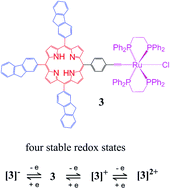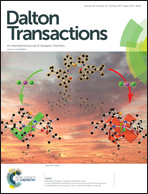New donor–acceptor conjugates based on a trifluorenylporphyrin linked to a redox–switchable ruthenium unit†‡
Abstract
Reactions of the 16-electron ruthenium complex [Ru(dppe)2Cl][PF6] with metal-free and zinc ethynylphenyltrifluorenylporphyrins 1 and 2 respectively, gave the new dyads 3 and 4 with ethynylruthenium group as a potential electron donor and the porphyrin as a potential electron acceptor. The redox properties of the porphyrins 1–4 were investigated by cyclic voltammetry and UV spectroelectrochemistry (SEC), which reveal that the monocation and monoanion of metal-free porphyrin 1 are stable under these conditions whereas the formation of the corresponding radical cation or anion of the zinc porphyrin 2 was accompanied by partial decomplexation of the zinc ion. Oxidations of the dyads 3 and 4 gave stable radical cations as probed using IR, NIR and UV SEC methods. These cations show similar NIR and IR bands to those reported for the known 17-electron [Ru(dppe)2(C![[triple bond, length as m-dash]](https://www.rsc.org/images/entities/char_e002.gif) CPh)Cl]+ radical cation. Remarkably, the dyad 3 has four stable redox states +2/+1/0/−1 where the second oxidation and first reduction processes take place at the porphyrin unit. Simulated absorption spectra on 1–4 at optimised geometries obtained by TD-DFT computations with the CAM-B3LYP functional are shown to be in very good agreement with the observed UV absorption spectra of 1–4. The spectra of 1–4 and their oxidised and reduced species were interpreted with the aid of the TD-DFT data. Fluorescence measurements reveal that the dyads 3 and 4 are only weakly emitting compared to 1 and 2, indicative of quenching of the porphyrinic singlet excited state by the ruthenium centre.
CPh)Cl]+ radical cation. Remarkably, the dyad 3 has four stable redox states +2/+1/0/−1 where the second oxidation and first reduction processes take place at the porphyrin unit. Simulated absorption spectra on 1–4 at optimised geometries obtained by TD-DFT computations with the CAM-B3LYP functional are shown to be in very good agreement with the observed UV absorption spectra of 1–4. The spectra of 1–4 and their oxidised and reduced species were interpreted with the aid of the TD-DFT data. Fluorescence measurements reveal that the dyads 3 and 4 are only weakly emitting compared to 1 and 2, indicative of quenching of the porphyrinic singlet excited state by the ruthenium centre.

- This article is part of the themed collection: In memory of Professor Kenneth Wade


 Please wait while we load your content...
Please wait while we load your content...